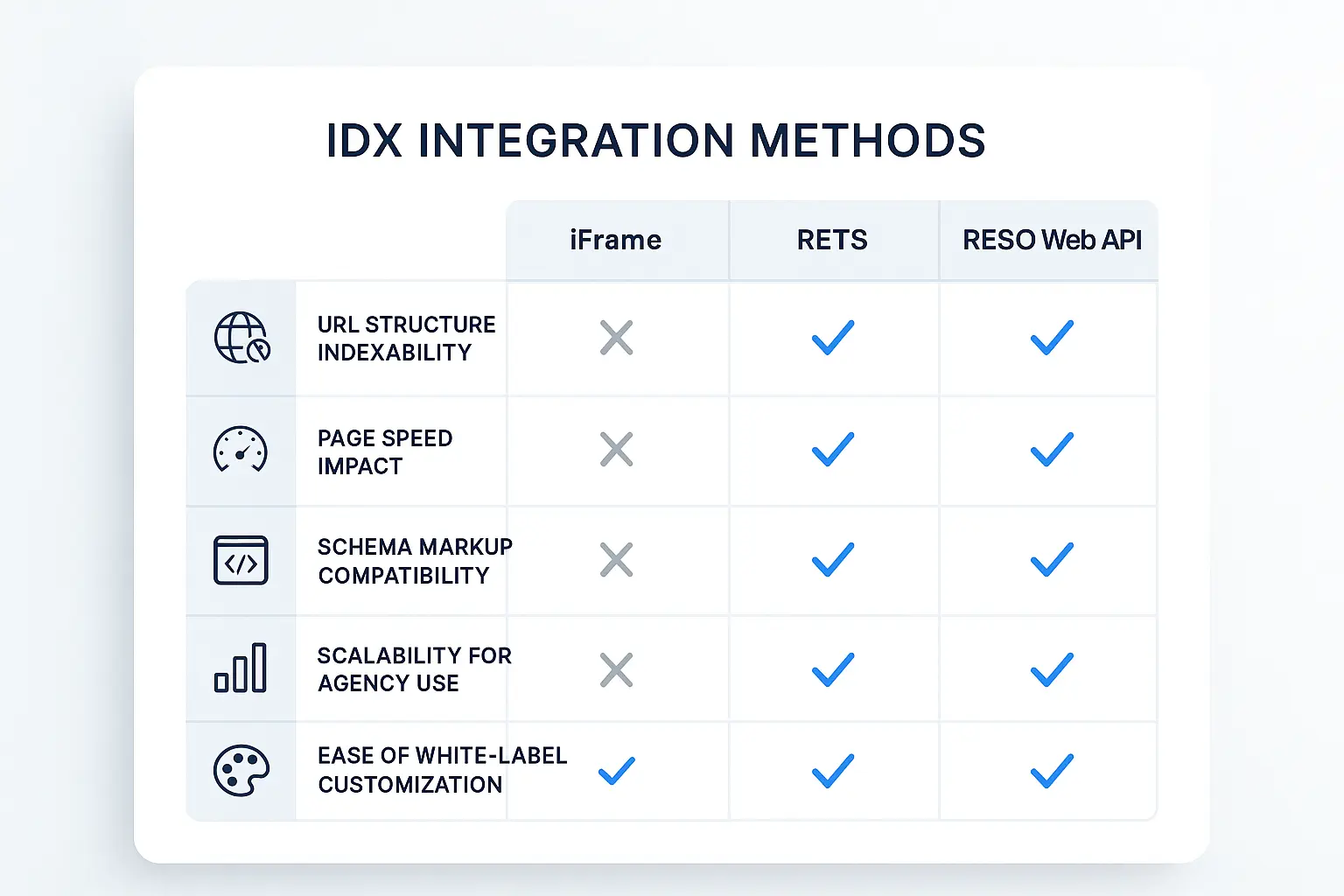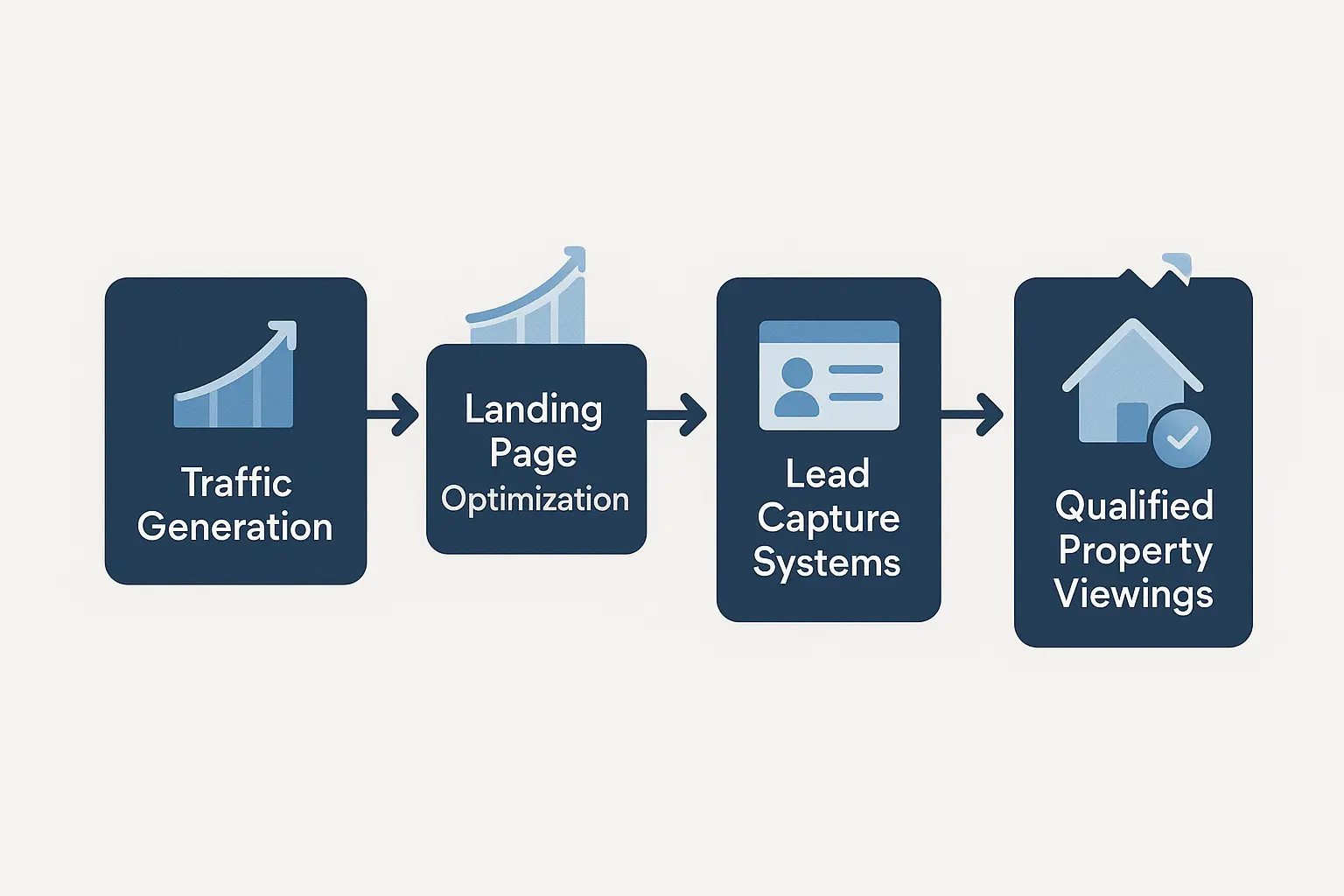You’ve read the guides. You know the basics of keyword research, the importance of a Google Business Profile, and the value of neighborhood pages.
Yet, when it comes to delivering real estate SEO for multiple clients, those “ultimate guides” fall short. They teach you how to fish for one, not how to build a commercial fishing fleet.
The real challenge for agencies isn’t just understanding SEO; it’s executing it at scale without drowning in manual tasks or hiring expensive, specialized talent. How do you create unique content for 50 different neighborhoods? How do you manage the technical nightmare of a bad IDX integration? Most importantly, how do you turn traffic into tangible property viewings for your clients?
This isn’t another beginner’s guide. This is an agency’s playbook for building a profitable, scalable, and high-impact real estate SEO service. It’s a framework for moving beyond one-off tactics to build a system that drives predictable growth for your clients and your agency.
Chapter 1: The Foundation – An Agency Audit for New Real Estate Clients
Before you can build, you need a blueprint. Top competitors like Backlinko and Carrot cover the fundamentals well, but an agency needs more than a checklist—you need a rapid diagnostic tool. When onboarding a new real estate client, use this framework to audit their digital foundation and identify immediate opportunities.
The 3-Point Agency Audit Checklist
1. Technical & On-Page Health:
Indexing & Crawlability: Is their IDX integration creating thousands of low-value, duplicate pages? Or worse, is it an iFrame that Google can’t even see? A quick site:domain.com search can reveal major indexing issues.
Mobile-First Experience: With mobile devices driving 52% of real estate PPC clicks, a slow or clunky mobile site is an absolute conversion killer. Test core pages on mobile for speed and usability.
URL Structure: Are property pages buried under cryptic URLs? Clean, keyword-rich URLs for listings and neighborhood pages are non-negotiable.
2. Local Authority & Trust:
Google Business Profile (GBP) Consistency: Do they have one profile for the brokerage and separate, optimized profiles for key agents? Inconsistent NAP (Name, Address, Phone) information across the web is a common problem that’s easy to fix. Since 86% of consumers use GBP to find local info, this is your low-hanging fruit.
Review Velocity & Quality: Are they actively generating reviews? A steady stream of positive feedback is a powerful local ranking signal.
Hyperlocal Signals: Do they have dedicated pages for the specific neighborhoods, subdivisions, or condo buildings they specialize in? This is where you outmaneuver Zillow.
3. Content & Conversion Gaps:
Beyond Listings: Does their content strategy move beyond property listings? Look for agent bios, community guides, and resources for buyers and sellers.
Call-to-Action (CTA) Clarity: Is “Contact Us” their only call to action? Every page should have a clear, compelling next step, like “Schedule a Viewing,” “Download the Neighborhood Guide,” or “Get a Free Home Valuation.”
Lead Capture Mechanics: How are leads captured and nurtured? A leaky bucket here means wasted traffic, no matter how high you rank.

Chapter 2: The Hyperlocal Content Engine – A Framework for Dominating Neighborhoods at Scale
Creating one great neighborhood page is easy. Creating one hundred is an operational nightmare—unless you have a system. This is the single biggest area where agencies can provide immense value and where generic guides offer no real solutions. The goal is to build a content engine, not just write articles.
The Scalable Hyperlocal Workflow
- Templatize Your Content: Create a master template for neighborhood pages. It should include modular sections that can be customized:
Market stats (average home price, days on market).
Local amenities (parks, schools, restaurants).
Resident testimonials or quotes.
An embedded map of the area.
Live property listings for that neighborhood (via a proper IDX feed).
- Systematize Data Collection: Use a combination of tools and processes to gather unique data for each neighborhood. This can involve AI assistants for initial research, VAs to verify school district data, and client questionnaires to capture local insights.
- Automate to Execute: Leverage AI-powered content workflows to draft initial versions based on your templates and data. This allows your team to focus on refining, editing, and adding the human touch of local expertise, rather than starting from a blank page. This is how you achieve the scale to serve multiple clients effectively without burning out your team.
This system transforms a time-consuming creative task into a predictable, repeatable process. It’s the core of a scalable service offering and a key differentiator for your agency.
Chapter 3: The Technical Pillar – Advanced IDX Integration for Maximum SEO Value
Here’s a hard truth most SEO guides gloss over: your client’s entire real estate SEO strategy can be undermined by a poor IDX (Internet Data Exchange) integration. As an agency, getting this right is a massive technical win that clients will value immensely.
Many brokerages use simple iFrame solutions because they are cheap and easy, but these are often invisible to Google, providing zero SEO value. The next step up, RETS, is better but is being phased out. The modern standard is the RESO Web API, which offers the most flexibility for creating SEO-friendly, indexable content.
Understanding the difference is critical for advising your clients and executing a strategy that works.
Your job as the agency is to ensure the chosen IDX solution allows you to:
Create Unique, Indexable URLs for Every Listing: domain.com/listings/123-main-street is infinitely better than a parameter-driven URL that Google might mistake for duplicate content.
Customize Page Titles and Meta Descriptions: You need control to optimize these elements for target keywords (e.g., “3-bedroom home for sale in Northwood, Irvine”).
Ensure Fast Page Load Speeds: A slow-loading property search can crush user experience and rankings.
Navigating this technical landscape is complex, which is why an expert white-label SEO partner can provide the deep technical execution needed to build a powerful SEO foundation for your clients.

Chapter 4: The Local Pack Blueprint – Mastering Google Business Profile for Agencies
For real estate, the local map pack is prime digital real estate. While competitors offer solid advice for a single agent, an agency needs a blueprint for managing multiple brokerages and their agents efficiently.
Agency-Level GBP Management
Brokerage & Agent Hierarchy: Establish the main brokerage profile as the central hub. Then, create and optimize individual agent profiles, ensuring they are correctly associated with the brokerage but have unique descriptions and attributes.
Content Cadence with Google Posts: Use Google Posts systematically to feature new listings, open houses, market updates, and positive client reviews. This practice keeps the profile fresh and engaging.
Review Management System: Implement a process for soliciting reviews for both the brokerage and individual agents. Respond to all reviews—positive and negative—promptly to demonstrate engagement.
Centralized Reporting: Use a dashboard to track key GBP metrics (views, clicks to website, calls) across all your real estate clients to demonstrate clear, localized value.

Chapter 5: The Niche Opportunity – SEO for Commercial Real Estate (CRE)
One of the largest content gaps our research identified is the lack of focus on Commercial Real Estate (CRE). This underserved market has different keywords, different user intent, and a different sales cycle. Targeting this niche can set your agency apart.
Keyword Strategy: Shift focus from “homes for sale” to terms like “office space for lease,” “retail property investment,” or “industrial warehouse Dallas.” The searcher is an investor or business owner, not a homebuyer.
Content Types: The content must be data-rich and professional. Think beyond blog posts to downloadable market reports, investment guides, property-type deep dives (e.g., Class A vs. Class B office space), and case studies of successful transactions.
Link Building: Authority in this space comes from different sources. Target links from local business journals, financial news sites, and commercial real estate industry publications.
Offering specialized CRE SEO is a powerful way to attract higher-value clients and build a reputation as a true real estate marketing expert.
Chapter 6: The Conversion Framework – From Clicks to Property Viewings
Traffic and rankings are vanity metrics if they don’t lead to business results. The final—and most crucial—piece of the playbook is turning search visibility into scheduled viewings. Our data shows that organic search traffic converts at 3.2%—more than double the rate of paid search—which makes this the most critical funnel to optimize.
The Clicks-to-Viewings Roadmap
- The Landing Page: Every property listing page is a landing page. It must load fast and immediately provide the most critical information: high-quality photos, price, address, and a clear call-to-action.
- The Compelling CTA: Replace passive CTAs like “Learn More” with action-oriented ones. “Request a Private Tour,” “See a Virtual Walkthrough,” or “Ask the Listing Agent a Question” are more effective because they offer a specific, valuable next step.
- The Frictionless Lead Capture: Once a user clicks, make the next step easy. Use simple forms that only ask for essential information (name, email, phone). Better yet, offer calendar integration to let qualified leads book a viewing time directly.
- The Immediate Follow-up: Connect the lead capture form directly to the agent’s CRM. An automated email and text message should be sent instantly to confirm the request and let the prospect know what to expect next. Speed-to-lead is everything in real estate.
By focusing on this conversion framework, you shift the conversation with your client from rankings to revenue. You’re no longer just an SEO provider; you’re a growth partner.

Conclusion: Your Execution Partner – Implementing the Playbook with JVGLABS
This playbook provides the strategic framework to build a highly effective and scalable real estate SEO service. But strategy without execution is just a plan on paper.
The complexities of advanced IDX integration, the operational demands of a hyperlocal content engine, and the constant need to optimize for conversions require specialized expertise and significant resources. For many agencies, building this capability in-house is slow, expensive, and risky.
This is where JVGLABS comes in. We are the invisible execution team behind your brand. Our AI-powered automation and expert strategists handle the complex, time-consuming tasks outlined in this playbook. You maintain the client relationship and focus on strategy while we deliver results under your brand. We empower you to scale SEO delivery and offer a sophisticated, growth-focused service without adding to your payroll.
Frequently Asked Questions for Agencies
How does a white-label partnership work for our real estate clients?
It’s a seamless process. You own the client relationship. We work in the background, executing the SEO strategy. All deliverables, reports, and communications are branded with your agency’s logo and voice. Your client sees you as the expert delivering exceptional results; we remain your silent, invisible execution partner.
Can your systems integrate with the specific IDX provider our client uses?
Yes. Our technical team has deep experience with a wide range of real estate technologies, including various IDX providers and the RESO Web API standard. During onboarding, we conduct a thorough technical audit to ensure our execution strategy aligns perfectly with your client’s tech stack for maximum SEO impact.
How do you create unique hyperlocal content without it sounding generic or automated?
Our process combines AI efficiency with human expertise. We use our omnichannel growth SEO approach, where AI handles the heavy lifting of data gathering and initial drafting based on proven templates. Then, our expert content strategists, in collaboration with your team, refine and enrich the content with unique local insights, client-specific details, and compelling narratives. This ensures every piece is both scalable and authentic.

